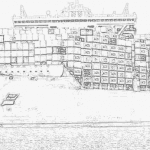The present state of Assam occupies the strategic north-east frontier region of the Indian Union. With the attainment of independence by India and the partition of the country into India and Pakistan the pendulum of frontier strategy has swung from the north-west to the north-east frontier where India marches with Tibet, China and Burma, and also Pakistan, over hundreds of miles. The recent stirrings in the hills on the north-east frontier areas of Assam where the modern age seems to have dawned slowly only after India’s achievement of freedom, have focussed much wider attention than before in the political and historical importance of this state which in British days continued to be more or less a backward province.
In ancient times Assam formed part of a mighty kingdom known as Pragjyotisha or Kamarupa with its territories extending on the west to the river Karatoya which now flows through East Bengal. We find mention of this great kingdom in the ancient Epics and Puranas and the works of poets and writers like Kalidasa and Banabhatta. The great Chinese traveler Hiuen Tsang visited this land in the first half of the seventh century when Kumar Vaskar Burman, who traced his descent from the mythological Naarakasur, was the ruling prince at Pragjyotishpur (modern Gauhati) the capital of the ancient kingdom. Hiuen Tsang has in his accounts testified to the greatness of this kingdom and its ruler.
The name Assam was unknown in the past. It came to use only after the Ahoms, a Mongolian race that entered Assam from the north-east in the thirteenth century, established their dominion in the Brahmaputra Valley which lasted for six hundred years until the advent of the British in the third decade of the nineteenth century. The rise and growth of the Ahom power provided a bulwark of defence for this eastern state against the onslaughts of the Muslims from the west whose attacks resulted in the ultimate dismemberment of the Koch Kingdom comprising the western half of the old Kamarupa kingdom at the close of the sixteenth century.
From ancient times Assam has been a land of fusion of races and cultures. The contribution of the Mongoloid stream of races to the history and culture of India can best be studied in Assam. Here from very ancient times enlightened Aryans have inter-mingled with non-Aryans, Mongolians and Dravidians, to constitute the historic Assamese people and to bear that composite fruit of Indian culture known as Assamese culture which is predominated by Aryan, but has in its veins non-Aryan elements that gave it many of its distinctive traits. The non-Aryan conquerors of Assam including the Ahoms gradually yielded to the influence of the culture and civilisation of the conquered Aryanised races. As a result there evolved in Assam new forms of Hindu religious beliefs and new codes of customs which are at variance with, but not far removed from, Aryan orthodoxy. It has aptly been said, “To Indologists working in a wider field Assam is a new mine for exploration. Apart from the fusion of the Aryan and non-Aryan elements, and their co-extensive paralleled or separate developments traceable in the social, religious and political institutions of the people, the ruins and remnants of its ancient architecture and iconography will help us to re-interest those of other parts of India. The recorded materials of Assam will throw light on the history of ancient and medieval India.”
The glorious past history of Assam, the history of the pre-Ahom period, has been reconstructed more or less on the basis of the information contained in the Epics and Puranas and other contemporary literature, the accounts of foreign travellers like Hiuen-Tsang, the stone and copperplate inscriptions throwing light on the reigns of different dynasties, and by a study of the architectural and iconographic remains. More inscriptions and remains of architecture and sculpture are expected to come to light as the labours of investigators are intensified and the gaps in our knowledge of the remote past may in due course be filled up, and even new lights may be thrown on things that we already know.
Assam has been said to be an inexhaustible mine of recorded materials for her history. She in fact occupies a unique position in the whole of India in her possession of a vast treasure in the shape of her historical literature known as the Buranjis. The Ahom conquerors of Assam had a keen sense of history which they succeeded in infusing into the minds of the Assamese people. Under their auspices the Buranjis or historical chronicles of the reigns of the Ahom kings began systematically to be written and preserved in manuscripts both in the Ahom and Assamese languages. The Buranjis are faithful records of all that happened in the different reigns that they cover and even refer to events that happened outside the kingdom in contemporary India. These voluminous compilations maintained in the royal archive and also in the archives of private individuals, especially the nobles of the court, stand to the credit of different writers or compilers engaged by the court or the nobles, and they have preserved for succeeding generations a picture of the political and social condition of the times. They give us the intricate details of the working of the Ahom state machinery for over six hundred years, the history of the political, social and religious institutions that were built up in the country, the accounts of the foreign onslaughts that befell the country and were repulsed, and a picture of the language, customs and usages, and beliefs that flourished during that eventful period.
It is interesting to find that the historical literature of Assam of this period contains, besides the regular Buranjis of the Ahom Court and its relations with the races and kingdoms with which it came in contact during the course of the expansion of its dominion, also Buranjis dealing with separate tribes like the Kacharis and Jaintias who played an important role in the history of the period, and with neighbouring kingdoms like Tripura which were visited by diplomatic missions from the Ahom court. These Buranjis give us an insight into the character and activities of some contemporary races and kingdoms which is of immense value to the historian. There are also Buranjis like the Patshah Buranji dealing with Ahom-Mogul relations which light up many a dark corner of contemporary Indian affairs and give us glimpses of the Mogul court through Assamese eyes.
The neo-vaishnavite religious revival in Assam brought about by Sri Sankaradeva and his disciples in the fifteenth and sixteenth centuries resulted in a literary renaissance which firmly built the foundations of modern Assamese language and literature. In the wake of this movement came to be composed various ‘Charit-Puthis’ (biographies of religious leaders) and later on accounts of religious institutions like the Suttras which also contain valuable historical materials relating to the political and social conditions of the times. There are also dynastic accounts of some non-Ahom royal houses such as the Durrang-Raj-Vamsabali which gives a connected account of the Koch kingdom of Koch Behar, an offshoot of which later ruled at Durrang under the suzerainty of the Ahoms.
Thus the historical instinct of the Assamese people who have ever been proud of their glorious heritage found manifold expressions, and thus was bequeathed to posterity a wealth of historical literature which it will be difficult to find anywhere else in India. Ahom rule collapsed as a result of the Burmese invasions of Assam that began in 1816 and Assam passed into the hands of the British in 1826 as a result of the Treaty of Yandabu between the Burmese and the British Govt. in India. The Ahom royal Archives broke up but the Buranjis were not lost. According to the custom of the age manuscripts of Buranjis remained in possession of important families along with manuscripts of religious literature. If some of the manuscripts were lost or destroyed due to untoward circumstances, others were preserved till their importance was realised in the present age with the growth of historical and other branches of learning.
Modern historical and anthropological studies in Assam owe their origin to the pioneering zeal of some of the British administrators of Assam which later brought some indigenous scholars into the field. Early British officers in Assam like Col. Jenkins, Hannay, Micosh, Pemberton and Robinson, made explorary studies on the population and resources of Assam and the results of their studies were embodied generally in lengthy official reports and occasionally published for wider knowledge in journals of the time like the Journal of the Royal Asiatic Society of Bengal. In 1894 the Department of Ethnography was established by the Provincial Govt. acting under the advice of Mr. (later Sir) Edward Gait. Sir Charles James Lyall, then officiating Chief Commissioner of Assam, stressed the need of collecting the historical manuscripts of Assam which had escaped destruction for preservation and utilisation for historical research. Mr. Gait began conducting historical research by initiating a collecting of coins, inscriptions and historical and other documents bearing on the history of Assam. He utilised these materials in his ‘History of Assam’ published in 1906.
Historical studies received a new impetus early in the present century when the Kamarupa Anusandhan Samity (Assam Research Society) was established at Gauhati in 1912. A systematic effort began soon to be made for collection of manuscripts and other historical relics. A large body of historical and literary manuscripts was collected by Pandit Hem Chandra Goswami in 1912-13. The work of historical research was also taken up by a few scholars. In 1928 the Provincial Govt. saw the utility of establishing a separate Department of Historical and Antiquarian Studies in Assam apart from the Department of Ethnography mentioned above.
Much valuable work was done by this Department soon after its establishment by editing and publishing a number of old Assamese Buranjis. The credit for this useful work goes to Dr. S. K. Bhuyan whose diligence and scholarship made the Department what it is today—an institution for collection and preservation of ancient manuscripts which also embodies the results of Dr. Bhuyan’s fruitful researches in them. The Buranjis edited and published by this Department were generally well received by the scholarly world. But the activities of the Department later slowed down due to paucity of funds for schemes of expansion and lack of personnel to engage in research work. Of late an attempt is being made by the Department to collect more of Ahom manuscripts both historical and religions from the possession of private individuals for better preservation and further researches into the history and culture of the Ahoms.
Research Officer, Govt. of Assam.
K. N. Dutt a Research Officer, Govt. of Assam. writes on Indian Review.




Leave a Reply